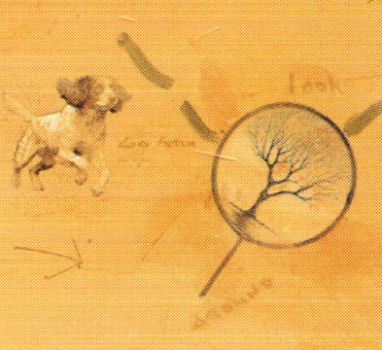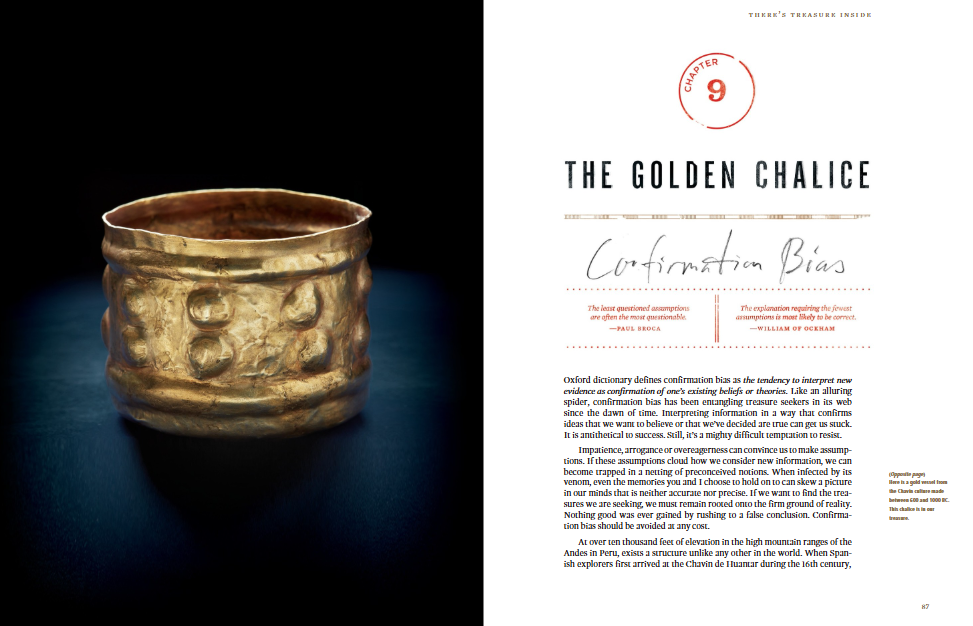Jon Collins-Black gives advice on how to avoid confirmation bias in treasure hunts.
In chapter 9 of There’s Treasure Inside – which is the chapter with the missing page 90! – Jon writes about avoiding confirmation bias. It is even the subtitle for the chapter on The Golden Chalice. He begins with providing a definition:
Jon says it is: “the tendency to interpret new evidence as confirmation of one’s existing beliefs or theories.”
He also offers advice on how to avoid it:
“If we want to find the treasures we are seeking, we must remain rooted onto the firm ground of reality. Nothing good was ever gained by rushing to a false conclusion. Confirmation bias should be avoided at any cost.”
After stating this Jon goes on to describe the Chavin culture and their mysterious, powerful, ceremonies. How the high priests created experiences through natural means, but those persons involved believed these experiences were produced by the gods. Jon says the golden chalice – included in one of the treasure boxes – may have even been used during the experiences.
It’s interesting – those taking part in this supernatural experience – are being falsely led – of which Jon refers to having suffered from confirmation bias. He writes how they were fooled, ‘what, but the gods themselves, could have created such a place.’
It’s almost as if here Jon is hinting to red herrings in the book. These false leads have us ignoring other options or clues being given in another way.
Jon provides another example in the chapter. He tells the story of when he was 4 years old, and his mother took him to the Christmas Eve service – thinking he would be able to sit quietly. This went against the fact he was a spirited child, and what his father was reminding her of. It turned out the facts won – he was too lively to sit for the service.
Jon says his mother fell into the trap of confirmation bias – she wanted to believe something instead of acknowledging all the other facts. Jon writes, “She debated with my dad, recalling moments of my good behavior as examples, ignoring the majority of times when I had failed to sit still and be quiet…..”
I think there are red herrings in the book – and Jon is warning us to the fact – by warning us of confirmation bias.
Take for example, in the Pokémon Treasure Box chapter – the end photo – which is of a ‘bluff’ – is this hinting something in the story is a ‘bluff’ – a red herring – a false lead?
In chapter 9, Jon also writes: “Look both ways before crossing.”
For the Appalachian Footpath Box Chapter – there are clues to both North Carolina and Vermont. (and even others). Jon writes in chapter 9, “…be willing to consider different options and explore new possibilities. Look both ways before crossing.”
We see multiple paths for the treasure boxes……. It seems we will need to look ‘multiple ways’ – and go with the stronger trail of clues….. those that nicely fit and are not forced….
It seems that even though something might suggest a different location – like possibly the Matched trail in VT – the majority of clues – might lead elsewhere – sort of like the story of the Christmas eve story with his mother – there were times he sat well – but the majority said not.
Is this how the Appalachian Footpath Box map and all the clues to the boxes – need to be weighed? While some clues lead one way – Jon is warning us to look both ways to determine where is the majority?
Something to think about – and thoughts on how to avoid confirmation bias in treasure hunts.


